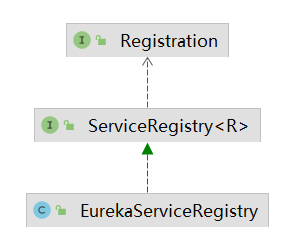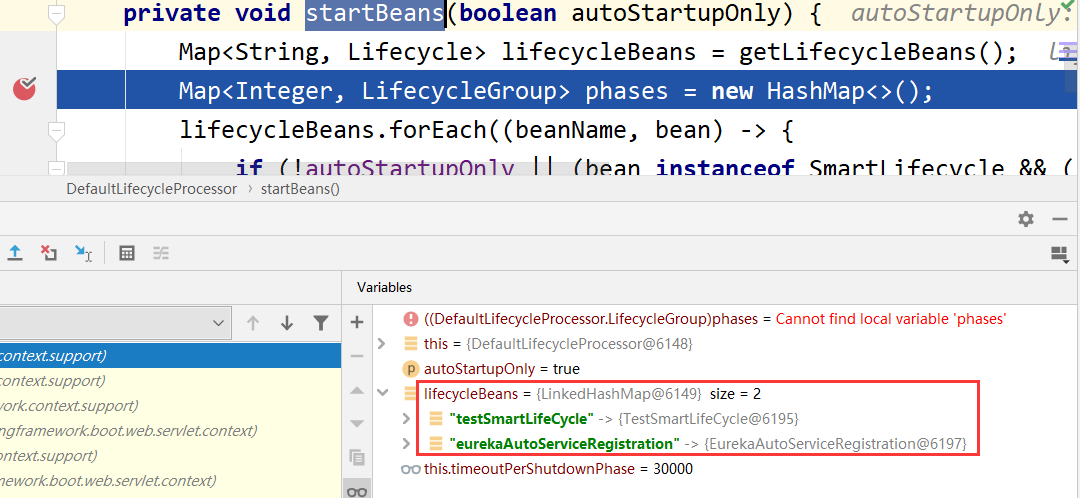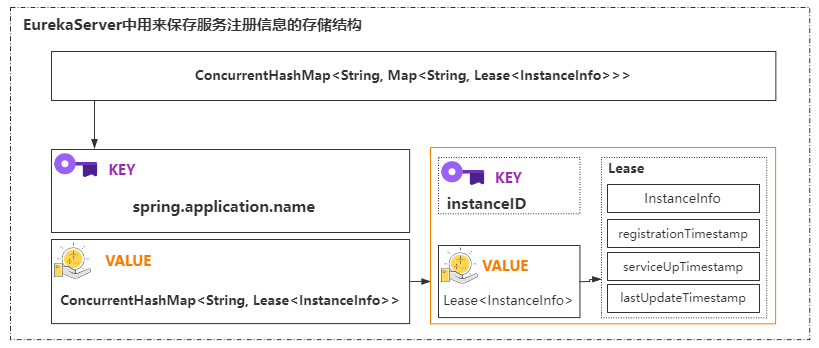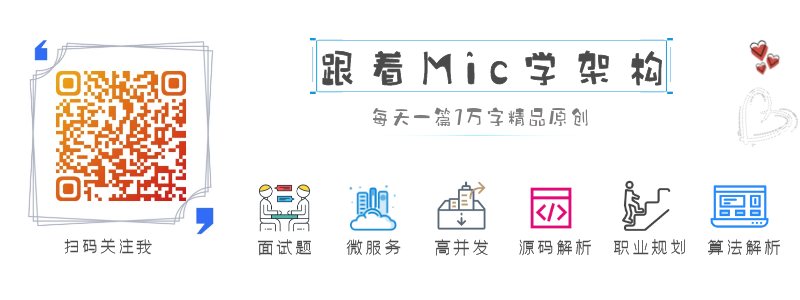Spring Cloud Eureka源码分析之服务注册的流程与数据存储设计!

Spring Cloud是一个生态,它提供了一套标准,这套标准可以通过不同的组件来实现,其中就包含服务注册/发现、熔断、负载均衡等,在spring-cloud-common这个包中,org.springframework.cloud.client.serviceregistry路径下,可以看到一个服务注册的接口定义ServiceRegistry。它就是定义了spring cloud中服务注册的一个接口。
public interface ServiceRegistry<R extends Registration> {
void register(R registration);
void deregister(R registration);
void close();
void setStatus(R registration, String status);
<T> T getStatus(R registration);
}
我们看一下它的类关系图,这个接口有一个唯一的实现EurekaServiceRegistry。表示采用的是Eureka Server作为服务注册中心。

自动注册的触发机制
Eureka自动注册,是通过EurekaAutoServiceRegistration这个对象来触发的。
在Spring Boot项目启动时,会基于自动装配机制,在EurekaClientAutoConfiguration这个配置类中,初始化一个EurekaAutoServiceRegistration这个Bean对象,代码如下。
public class EurekaClientAutoConfiguration {
@Bean
@ConditionalOnBean(AutoServiceRegistrationProperties.class)
@ConditionalOnProperty(
value = "spring.cloud.service-registry.auto-registration.enabled",
matchIfMissing = true)
public EurekaAutoServiceRegistration eurekaAutoServiceRegistration(
ApplicationContext context, EurekaServiceRegistry registry,
EurekaRegistration registration) {
return new EurekaAutoServiceRegistration(context, registry, registration);
}
}
EurekaAutoServiceRegistration这个类的定义如下。
public class EurekaAutoServiceRegistration implements AutoServiceRegistration,
SmartLifecycle, Ordered, SmartApplicationListener {
//省略
@Override
public void start() {
// only set the port if the nonSecurePort or securePort is 0 and this.port != 0
if (this.port.get() != 0) {
if (this.registration.getNonSecurePort() == 0) {
this.registration.setNonSecurePort(this.port.get());
}
if (this.registration.getSecurePort() == 0 && this.registration.isSecure()) {
this.registration.setSecurePort(this.port.get());
}
}
// only initialize if nonSecurePort is greater than 0 and it isn't already running
// because of containerPortInitializer below
if (!this.running.get() && this.registration.getNonSecurePort() > 0) {
this.serviceRegistry.register(this.registration);
this.context.publishEvent(new InstanceRegisteredEvent<>(this,
this.registration.getInstanceConfig()));
this.running.set(true);
}
}
//省略...
}
我们发现,EurekaAutoServiceRegistration实现了SmartLifecycle接口,当Spring容器加载完所有的Bean并且初始化之后,会继续回调实现了SmartLifeCycle接口的类中对应的方法,比如(start)。
SmartLifeCycle知识拓展
我拓展一下SmartLifeCycle这块的知识, SmartLifeCycle是一个接口,当Spring容器加载完所有的Bean并且初始化之后,会继续回调实现了SmartLifeCycle接口的类中对应的方法,比如(start)。
实际上我们自己也可以拓展,比如在springboot工程的main方法同级目录下,写一个测试类,实现SmartLifeCycle接口,并且通过@Service声明为一个bean,因为要被spring去加载,首先得是bean。
@Service
public class TestSmartLifeCycle implements SmartLifecycle {
@Override
public void start() {
System.out.println("start");
}
@Override
public void stop() {
System.out.println("stop");
}
@Override
public boolean isRunning() {
return false;
}
}
接着,我们启动spring boot应用后,可以看到控制台输出了start字符串。
我们在DefaultLifecycleProcessor.startBeans方法上加一个debug,可以很明显的看到我们自己定义的TestSmartLifeCycle被扫描到了,并且最后会调用该bean的start方法。

在startBeans方法中,我们可以看到它首先会获得所有实现了SmartLifeCycle的Bean,然后会循环调用实现了SmartLifeCycle的bean的start方法,代码如下。
private void startBeans(boolean autoStartupOnly) {
Map<String, Lifecycle> lifecycleBeans = this.getLifecycleBeans();
Map<Integer, DefaultLifecycleProcessor.LifecycleGroup> phases = new HashMap();
lifecycleBeans.forEach((beanName, bean) -> {
if (!autoStartupOnly || bean instanceof SmartLifecycle && ((SmartLifecycle)bean).isAutoStartup()) {
int phase = this.getPhase(bean);
DefaultLifecycleProcessor.LifecycleGroup group = (DefaultLifecycleProcessor.LifecycleGroup)phases.get(phase);
if (group == null) {
group = new DefaultLifecycleProcessor.LifecycleGroup(phase, this.timeoutPerShutdownPhase, lifecycleBeans, autoStartupOnly);
phases.put(phase, group);
}
group.add(beanName, bean);
}
});
if (!phases.isEmpty()) {
List<Integer> keys = new ArrayList(phases.keySet());
Collections.sort(keys);
Iterator var5 = keys.iterator();
while(var5.hasNext()) {
Integer key = (Integer)var5.next();
((DefaultLifecycleProcessor.LifecycleGroup)phases.get(key)).start(); //循环调用实现了SmartLifeCycle接口的start方法。
}
}
}
SmartLifeCycle接口的回调,是在SpringBoot启动时触发,具体的执行路径如下!
SpringApplication.run() -> this.refreshContext(context);->this.refresh(context);->ServletWebServerApplicationContext.refresh()->this.finishRefresh();->AbstractApplicationContext.finishRefresh->DefaultLifecycleProcessor.onRefresh()-> this.startBeans->this.start()->this.doStart()->
服务注册
因此,当SpringBoot启动时,会触发在EurekaAutoServiceRegistration中的start方法,代码如下。
public class EurekaAutoServiceRegistration implements AutoServiceRegistration,
SmartLifecycle, Ordered, SmartApplicationListener {
//省略
@Override
public void start() {
// only set the port if the nonSecurePort or securePort is 0 and this.port != 0
if (this.port.get() != 0) {
if (this.registration.getNonSecurePort() == 0) {
this.registration.setNonSecurePort(this.port.get());
}
if (this.registration.getSecurePort() == 0 && this.registration.isSecure()) {
this.registration.setSecurePort(this.port.get());
}
}
// only initialize if nonSecurePort is greater than 0 and it isn't already running
// because of containerPortInitializer below
if (!this.running.get() && this.registration.getNonSecurePort() > 0) {
//实现服务注册。
this.serviceRegistry.register(this.registration);
//发布一个事件
this.context.publishEvent(new InstanceRegisteredEvent<>(this,
this.registration.getInstanceConfig()));
this.running.set(true);
}
}
//省略...
}
EurekaServiceRegistry.register
this.serviceRegistry.register(this.registration);,实际调用的是EurekaServiceRegistry这个对象中的register方法,代码如下。
public class EurekaServiceRegistry implements ServiceRegistry<EurekaRegistration> {
private static final Log log = LogFactory.getLog(EurekaServiceRegistry.class);
@Override
public void register(EurekaRegistration reg) {
maybeInitializeClient(reg);
if (log.isInfoEnabled()) {
log.info("Registering application "
+ reg.getApplicationInfoManager().getInfo().getAppName()
+ " with eureka with status "
+ reg.getInstanceConfig().getInitialStatus());
}
//设置当前实例的状态,一旦这个实例的状态发生变化,只要状态不是DOWN,那么就会被监听器监听并且执行服务注册。
reg.getApplicationInfoManager()
.setInstanceStatus(reg.getInstanceConfig().getInitialStatus());
//设置健康检查的处理
reg.getHealthCheckHandler().ifAvailable(healthCheckHandler -> reg
.getEurekaClient().registerHealthCheck(healthCheckHandler));
}
}
从上述代码来看,注册方法中并没有真正调用Eureka的方法去执行注册,而是仅仅设置了一个状态以及设置健康检查处理器。我们继续看一下reg.getApplicationInfoManager().setInstanceStatus方法。
public synchronized void setInstanceStatus(InstanceStatus status) {
InstanceStatus next = instanceStatusMapper.map(status);
if (next == null) {
return;
}
InstanceStatus prev = instanceInfo.setStatus(next);
if (prev != null) {
for (StatusChangeListener listener : listeners.values()) {
try {
listener.notify(new StatusChangeEvent(prev, next));
} catch (Exception e) {
logger.warn("failed to notify listener: {}", listener.getId(), e);
}
}
}
}
在这个方法中,它会通过监听器来发布一个状态变更事件。ok,此时listener的实例是StatusChangeListener,也就是调用StatusChangeListener的notify()方法。这个事件是触发一个服务状态变更,应该是有地方会监听这个事件,然后基于这个事件。
这个时候我们以为找到了方向,然后点击进去一看,卞击,发现它是一个接口。而且我们发现它是静态的内部接口,还无法直接看到它的实现类。
依我多年源码阅读经验,于是又往回找,因为我基本上能猜测到一定是在某个地方做了初始化的工作,于是,我想找到EurekaServiceRegistry.register方法中的reg.getApplicationInfoManager这个实例是什么,而且我们发现ApplicationInfoManager是来自于EurekaRegistration这个类中的属性。
public class EurekaRegistration implements Registration {
private final ApplicationInfoManager applicationInfoManager;
private ObjectProvider<HealthCheckHandler> healthCheckHandler;
private EurekaRegistration(CloudEurekaInstanceConfig instanceConfig,
EurekaClient eurekaClient, ApplicationInfoManager applicationInfoManager,
ObjectProvider<HealthCheckHandler> healthCheckHandler) {
this.eurekaClient = eurekaClient;
this.instanceConfig = instanceConfig;
this.applicationInfoManager = applicationInfoManager;
this.healthCheckHandler = healthCheckHandler;
}
}
而EurekaRegistration又是在EurekaAutoServiceRegistration这个类中实例化的。
那我们去EurekaAutoServiceRegistration这个配置类中,找一下applicationInfoManager的实例化过程,代码如下:
@Configuration(proxyBeanMethods = false)
@ConditionalOnMissingRefreshScope
protected static class EurekaClientConfiguration {
@Bean
@ConditionalOnMissingBean(value = ApplicationInfoManager.class,
search = SearchStrategy.CURRENT)
@org.springframework.cloud.context.config.annotation.RefreshScope
@Lazy
public ApplicationInfoManager eurekaApplicationInfoManager(
EurekaInstanceConfig config) {
InstanceInfo instanceInfo = new InstanceInfoFactory().create(config);
return new ApplicationInfoManager(config, instanceInfo); //构建了一个ApplicationInfoManager实例。
}
}
在ApplicationInfoManager的构造方法中,初始化了一个listeners对象,它是一个ConcurrentHashMap集合,但是初始化的时候,这个集合并没有赋值。
@Inject
public ApplicationInfoManager(EurekaInstanceConfig config, InstanceInfo instanceInfo, OptionalArgs optionalArgs) {
this.config = config;
this.instanceInfo = instanceInfo;
this.listeners = new ConcurrentHashMap<String, StatusChangeListener>();
if (optionalArgs != null) {
this.instanceStatusMapper = optionalArgs.getInstanceStatusMapper();
} else {
this.instanceStatusMapper = NO_OP_MAPPER;
}
// Hack to allow for getInstance() to use the DI'd ApplicationInfoManager
instance = this;
}
遇到这个问题,我们先别慌,先来看一下ApplicationInfoManager这个类中对listeners赋值的方法如下。
public void registerStatusChangeListener(StatusChangeListener listener) {
listeners.put(listener.getId(), listener);
}
这个方法唯一的调用方是:DiscoveryClient.initScheduledTasks方法。
这个方法又是在哪里调用的呢?
DiscoveryClient
在EurekaClientAutoConfiguration这个自动配置类的静态内部类EurekaClientConfiguration中,通过@Bean注入了一个CloudEurekaClient实例,代码如下。
@Configuration(proxyBeanMethods = false)
@ConditionalOnMissingRefreshScope
protected static class EurekaClientConfiguration {
@Autowired
private ApplicationContext context;
@Autowired
private AbstractDiscoveryClientOptionalArgs<?> optionalArgs;
@Bean(destroyMethod = "shutdown")
@ConditionalOnMissingBean(value = EurekaClient.class,
search = SearchStrategy.CURRENT)
public EurekaClient eurekaClient(ApplicationInfoManager manager,
EurekaClientConfig config) {
return new CloudEurekaClient(manager, config, this.optionalArgs,
this.context);
}
}
从名字不难猜测出,EurekaClient应该是专门负责和EurekaServer进行交互的客户端实现类,而这里返回的实例对象是CloudEurekaClient,构造代码如下。
public CloudEurekaClient(ApplicationInfoManager applicationInfoManager,
EurekaClientConfig config, AbstractDiscoveryClientOptionalArgs<?> args,
ApplicationEventPublisher publisher) {
super(applicationInfoManager, config, args);
this.applicationInfoManager = applicationInfoManager;
this.publisher = publisher;
this.eurekaTransportField = ReflectionUtils.findField(DiscoveryClient.class,
"eurekaTransport");
ReflectionUtils.makeAccessible(this.eurekaTransportField);
}
注意,在CloudEurekaClient这个类的构造方法中,传递了ApplicationInfoManager这个实例,后续会用到。
同时,该构造方法中会同步调用 super(applicationInfoManager, config, args); ,也就是调用父类DiscoveryClient的构造方法,代码如下。
public DiscoveryClient(ApplicationInfoManager applicationInfoManager, final EurekaClientConfig config, AbstractDiscoveryClientOptionalArgs args) {
this(applicationInfoManager, config, args, ResolverUtils::randomize);
}
最终会调用DiscoveryClient中重载的如下方法,代码比较长,把非关键代码省略。
DiscoveryClient(ApplicationInfoManager applicationInfoManager, EurekaClientConfig config, AbstractDiscoveryClientOptionalArgs args,
Provider<BackupRegistry> backupRegistryProvider, EndpointRandomizer endpointRandomizer) {
//省略....
if (config.shouldFetchRegistry()) { //是否要从eureka server上获取服务地址信息
this.registryStalenessMonitor = new ThresholdLevelsMetric(this, METRIC_REGISTRY_PREFIX + "lastUpdateSec_", new long[]{15L, 30L, 60L, 120L, 240L, 480L});
} else {
this.registryStalenessMonitor = ThresholdLevelsMetric.NO_OP_METRIC;
}
//是否要注册到eureka server上
if (config.shouldRegisterWithEureka()) {
this.heartbeatStalenessMonitor = new ThresholdLevelsMetric(this, METRIC_REGISTRATION_PREFIX + "lastHeartbeatSec_", new long[]{15L, 30L, 60L, 120L, 240L, 480L});
} else {
this.heartbeatStalenessMonitor = ThresholdLevelsMetric.NO_OP_METRIC;
}
logger.info("Initializing Eureka in region {}", clientConfig.getRegion());
//如果不需要注册并且不需要更新服务地址
if (!config.shouldRegisterWithEureka() && !config.shouldFetchRegistry()) {
logger.info("Client configured to neither register nor query for data.");
scheduler = null;
heartbeatExecutor = null;
cacheRefreshExecutor = null;
eurekaTransport = null;
instanceRegionChecker = new InstanceRegionChecker(new PropertyBasedAzToRegionMapper(config), clientConfig.getRegion());
// This is a bit of hack to allow for existing code using DiscoveryManager.getInstance()
// to work with DI'd DiscoveryClient
DiscoveryManager.getInstance().setDiscoveryClient(this);
DiscoveryManager.getInstance().setEurekaClientConfig(config);
initTimestampMs = System.currentTimeMillis();
initRegistrySize = this.getApplications().size();
registrySize = initRegistrySize;
logger.info("Discovery Client initialized at timestamp {} with initial instances count: {}",
initTimestampMs, initRegistrySize);
return; // no need to setup up an network tasks and we are done
}
try {
// default size of 2 - 1 each for heartbeat and cacheRefresh
//构建一个延期执行的线程池
scheduler = Executors.newScheduledThreadPool(2,
new ThreadFactoryBuilder()
.setNameFormat("DiscoveryClient-%d")
.setDaemon(true)
.build());
//处理心跳的线程池
heartbeatExecutor = new ThreadPoolExecutor(
1, clientConfig.getHeartbeatExecutorThreadPoolSize(), 0, TimeUnit.SECONDS,
new SynchronousQueue<Runnable>(),
new ThreadFactoryBuilder()
.setNameFormat("DiscoveryClient-HeartbeatExecutor-%d")
.setDaemon(true)
.build()
); // use direct handoff
//处理缓存刷新的线程池
cacheRefreshExecutor = new ThreadPoolExecutor(
1, clientConfig.getCacheRefreshExecutorThreadPoolSize(), 0, TimeUnit.SECONDS,
new SynchronousQueue<Runnable>(),
new ThreadFactoryBuilder()
.setNameFormat("DiscoveryClient-CacheRefreshExecutor-%d")
.setDaemon(true)
.build()
); // use direct handoff
eurekaTransport = new EurekaTransport();
scheduleServerEndpointTask(eurekaTransport, args);
AzToRegionMapper azToRegionMapper;
if (clientConfig.shouldUseDnsForFetchingServiceUrls()) {
azToRegionMapper = new DNSBasedAzToRegionMapper(clientConfig);
} else {
azToRegionMapper = new PropertyBasedAzToRegionMapper(clientConfig);
}
if (null != remoteRegionsToFetch.get()) {
azToRegionMapper.setRegionsToFetch(remoteRegionsToFetch.get().split(","));
}
instanceRegionChecker = new InstanceRegionChecker(azToRegionMapper, clientConfig.getRegion());
} catch (Throwable e) {
throw new RuntimeException("Failed to initialize DiscoveryClient!", e);
}
//如果需要注册到Eureka server并且是开启了初始化的时候强制注册,则调用register()发起服务注册
if (clientConfig.shouldFetchRegistry()) {
try {
//从Eureka-Server中拉去注册地址信息
boolean primaryFetchRegistryResult = fetchRegistry(false);
if (!primaryFetchRegistryResult) {
logger.info("Initial registry fetch from primary servers failed");
}
//从备用地址拉去服务注册信息
boolean backupFetchRegistryResult = true;
if (!primaryFetchRegistryResult && !fetchRegistryFromBackup()) {
backupFetchRegistryResult = false;
logger.info("Initial registry fetch from backup servers failed");
}
//如果还是没有拉取到,并且配置了强制拉取注册表的话,就会抛异常
if (!primaryFetchRegistryResult && !backupFetchRegistryResult && clientConfig.shouldEnforceFetchRegistryAtInit()) {
throw new IllegalStateException("Fetch registry error at startup. Initial fetch failed.");
}
} catch (Throwable th) {
logger.error("Fetch registry error at startup: {}", th.getMessage());
throw new IllegalStateException(th);
}
}
// call and execute the pre registration handler before all background tasks (inc registration) is started
//这里是判断一下有没有预注册处理器,有的话就执行一下
if (this.preRegistrationHandler != null) {
this.preRegistrationHandler.beforeRegistration();
}
//如果需要注册到Eureka server并且是开启了初始化的时候强制注册,则调用register()发起服务注册(默认情况下,shouldEnforceRegistrationAtInit为false)
if (clientConfig.shouldRegisterWithEureka() && clientConfig.shouldEnforceRegistrationAtInit()) {
try {
if (!register() ) {
throw new IllegalStateException("Registration error at startup. Invalid server response.");
}
} catch (Throwable th) {
logger.error("Registration error at startup: {}", th.getMessage());
throw new IllegalStateException(th);
}
}
// finally, init the schedule tasks (e.g. cluster resolvers, heartbeat, instanceInfo replicator, fetch
//初始化一个定时任务,负责心跳、实例数据更新
initScheduledTasks();
try {
Monitors.registerObject(this);
} catch (Throwable e) {
logger.warn("Cannot register timers", e);
}
// This is a bit of hack to allow for existing code using DiscoveryManager.getInstance()
// to work with DI'd DiscoveryClient
DiscoveryManager.getInstance().setDiscoveryClient(this);
DiscoveryManager.getInstance().setEurekaClientConfig(config);
initTimestampMs = System.currentTimeMillis();
initRegistrySize = this.getApplications().size();
registrySize = initRegistrySize;
logger.info("Discovery Client initialized at timestamp {} with initial instances count: {}",
initTimestampMs, initRegistrySize);
}
DiscoveryClient.initScheduledTasks
initScheduledTasks去启动一个定时任务。
- 如果配置了开启从注册中心刷新服务列表,则会开启cacheRefreshExecutor这个定时任务
- 如果开启了服务注册到Eureka,则通过需要做几个事情.
- 建立心跳检测机制
- 通过内部类来实例化StatusChangeListener 实例状态监控接口,这个就是前面我们在分析启动过程中所看到的,调用notify的方法,实际上会在这里体现。
private void initScheduledTasks() {
//如果配置了开启从注册中心刷新服务列表,则会开启cacheRefreshExecutor这个定时任务
if (clientConfig.shouldFetchRegistry()) {
// registry cache refresh timer
//registryFetchIntervalSeconds:30s
int registryFetchIntervalSeconds = clientConfig.getRegistryFetchIntervalSeconds();
//expBackOffBound:10
int expBackOffBound = clientConfig.getCacheRefreshExecutorExponentialBackOffBound();
cacheRefreshTask = new TimedSupervisorTask(
"cacheRefresh",
scheduler,
cacheRefreshExecutor,
registryFetchIntervalSeconds,
TimeUnit.SECONDS,
expBackOffBound,
new CacheRefreshThread()
);
scheduler.schedule(
cacheRefreshTask,
registryFetchIntervalSeconds, TimeUnit.SECONDS);
}
//如果开启了服务注册到Eureka,则通过需要做几个事情
if (clientConfig.shouldRegisterWithEureka()) {
int renewalIntervalInSecs = instanceInfo.getLeaseInfo().getRenewalIntervalInSecs();
int expBackOffBound = clientConfig.getHeartbeatExecutorExponentialBackOffBound();
logger.info("Starting heartbeat executor: " + "renew interval is: {}", renewalIntervalInSecs);
// 开启一个心跳任务
heartbeatTask = new TimedSupervisorTask(
"heartbeat",
scheduler,
heartbeatExecutor,
renewalIntervalInSecs,
TimeUnit.SECONDS,
expBackOffBound,
new HeartbeatThread()
);
scheduler.schedule(
heartbeatTask,
renewalIntervalInSecs, TimeUnit.SECONDS);
//创建一个instanceInfoReplicator实例信息复制器
instanceInfoReplicator = new InstanceInfoReplicator(
this,
instanceInfo,
clientConfig.getInstanceInfoReplicationIntervalSeconds(),
2); // burstSize
//初始化一个状态变更监听器
statusChangeListener = new ApplicationInfoManager.StatusChangeListener() {
@Override
public String getId() {
return "statusChangeListener";
}
@Override
public void notify(StatusChangeEvent statusChangeEvent) {
logger.info("Saw local status change event {}", statusChangeEvent);
instanceInfoReplicator.onDemandUpdate();
}
};
//注册实例状态变化的监听
if (clientConfig.shouldOnDemandUpdateStatusChange()) {
applicationInfoManager.registerStatusChangeListener(statusChangeListener); //注意(case)
}
//启动一个实例信息复制器,主要就是为了开启一个定时线程,每40秒判断实例信息是否变更,如果变更了则重新注册
instanceInfoReplicator.start(clientConfig.getInitialInstanceInfoReplicationIntervalSeconds());
} else {
logger.info("Not registering with Eureka server per configuration");
}
}
在上述代码中,我们发现了一个很重要的逻辑:applicationInfoManager.registerStatusChangeListener(statusChangeListener);
这个代码是注册一个StatusChangeListener,保存到ApplicationInfoManager中的listener集合中。 (还记得前面源码分析中的服务注册逻辑吗?当服务器启动或者停止时,会调用ApplicationInfoManager.listener,逐个遍历调用listener.notify方法),而这个listener集合中的对象是在DiscoveryClient初始化的时候完成的。
instanceInfoReplicator.onDemandUpdate()
这个方法的主要作用是根据实例数据是否发生变化,来触发服务注册中心的数据。
public boolean onDemandUpdate() {
if (rateLimiter.acquire(burstSize, allowedRatePerMinute)) { //限流判断
if (!scheduler.isShutdown()) { //提交一个任务
scheduler.submit(new Runnable() {
@Override
public void run() {
logger.debug("Executing on-demand update of local InstanceInfo");
//取出之前已经提交的任务,也就是在start方法中提交的更新任务,如果任务还没有执行完成,则取消之前的任务。
Future latestPeriodic = scheduledPeriodicRef.get();
if (latestPeriodic != null && !latestPeriodic.isDone()) {
logger.debug("Canceling the latest scheduled update, it will be rescheduled at the end of on demand update");
latestPeriodic.cancel(false);//如果此任务未完成,就立即取消
}
//通过调用run方法,令任务在延时后执行,相当于周期性任务中的一次
InstanceInfoReplicator.this.run();
}
});
return true;
} else {
logger.warn("Ignoring onDemand update due to stopped scheduler");
return false;
}
} else {
logger.warn("Ignoring onDemand update due to rate limiter");
return false;
}
}
InstanceInfoReplicator.this.run();
run方法调用register方法进行服务注册,并且在finally中,每30s会定时执行一下当前的run 方法进行检查。
public void run() {
try {
//刷新实例信息
discoveryClient.refreshInstanceInfo();
//是否有状态更新过了,有的话获取更新的时间
Long dirtyTimestamp = instanceInfo.isDirtyWithTime();
if (dirtyTimestamp != null) {//有脏数据,要重新注册
discoveryClient.register();
instanceInfo.unsetIsDirty(dirtyTimestamp);
}
} catch (Throwable t) {
logger.warn("There was a problem with the instance info replicator", t);
} finally {
//每隔30s,执行一次当前的`run`方法
Future next = scheduler.schedule(this, replicationIntervalSeconds, TimeUnit.SECONDS);
scheduledPeriodicRef.set(next);
}
}
DiscoveryClient.register
记过上述分析后,最终我们找到了Eureka的服务注册方法:eurekaTransport.registrationClient.register,最终调用的是 AbstractJerseyEurekaHttpClient#register(...)。
boolean register() throws Throwable {
logger.info(PREFIX + "{}: registering service...", appPathIdentifier);
EurekaHttpResponse<Void> httpResponse;
try {
httpResponse = eurekaTransport.registrationClient.register(instanceInfo);
} catch (Exception e) {
logger.warn(PREFIX + "{} - registration failed {}", appPathIdentifier, e.getMessage(), e);
throw e;
}
if (logger.isInfoEnabled()) {
logger.info(PREFIX + "{} - registration status: {}", appPathIdentifier, httpResponse.getStatusCode());
}
return httpResponse.getStatusCode() == Status.NO_CONTENT.getStatusCode();
}
AbstractJerseyEurekaHttpClient#register
很显然,这里是发起了一次http请求,访问Eureka-Server的apps/${APP_NAME}接口,将当前服务实例的信息发送到Eureka Server进行保存。
至此,我们基本上已经知道Spring Cloud Eureka 是如何在启动的时候把服务信息注册到Eureka Server上的了
public EurekaHttpResponse<Void> register(InstanceInfo info) {
String urlPath = "apps/" + info.getAppName();
ClientResponse response = null;
try {
Builder resourceBuilder = jerseyClient.resource(serviceUrl).path(urlPath).getRequestBuilder();
addExtraHeaders(resourceBuilder);
response = resourceBuilder
.header("Accept-Encoding", "gzip")
.type(MediaType.APPLICATION_JSON_TYPE)
.accept(MediaType.APPLICATION_JSON)
.post(ClientResponse.class, info);
return anEurekaHttpResponse(response.getStatus()).headers(headersOf(response)).build();
} finally {
if (logger.isDebugEnabled()) {
logger.debug("Jersey HTTP POST {}/{} with instance {}; statusCode={}", serviceUrl, urlPath, info.getId(),
response == null ? "N/A" : response.getStatus());
}
if (response != null) {
response.close();
}
}
}
服务注册总结
服务注册的过程分两个步骤
- DiscoveryClient这个对象,在初始化时,调用
initScheduledTask()方法,构建一个StatusChangeListener监听。 - Spring Cloud应用在启动时,基于SmartLifeCycle接口回调,触发StatusChangeListener事件通知
- 在StatusChangeListener的回调方法中,通过调用
onDemandUpdate方法,去更新客户端的地址信息,从而完成服务注册。
Eureka注册信息如何存储?
Eureka Server收到客户端的服务注册请求后,需要把信息存储到Eureka Server中,它的存储结构如下图所示。
EurekaServer采用了ConcurrentHashMap集合的方式。来存储服务提供者的地址信息,其中,每个节点的实例信息的最终存储对象是InstanceInfo。>

Eureka Server接收请求处理
请求入口在: com.netflix.eureka.resources.ApplicationResource.addInstance()。
大家可以发现,这里所提供的REST服务,采用的是jersey来实现的。Jersey是基于JAX-RS标准,提供REST的实现的支持,这里就不展开分析了。
Eureka Server端定义的服务注册接口实现如下:
@POST
@Consumes({"application/json", "application/xml"})
public Response addInstance(InstanceInfo info,
@HeaderParam(PeerEurekaNode.HEADER_REPLICATION) String isReplication) {
logger.debug("Registering instance {} (replication={})", info.getId(), isReplication);
// handle cases where clients may be registering with bad DataCenterInfo with missing data
//实例部署的数据中心, 这里是AWS实现的数据相关的逻辑,这里不涉及到,所以不需要去关心
DataCenterInfo dataCenterInfo = info.getDataCenterInfo();
if (dataCenterInfo instanceof UniqueIdentifier) {
String dataCenterInfoId = ((UniqueIdentifier) dataCenterInfo).getId();
if (isBlank(dataCenterInfoId)) {
boolean experimental = "true".equalsIgnoreCase(serverConfig.getExperimental("registration.validation.dataCenterInfoId"));
if (experimental) {
String entity = "DataCenterInfo of type " + dataCenterInfo.getClass() + " must contain a valid id";
return Response.status(400).entity(entity).build();
} else if (dataCenterInfo instanceof AmazonInfo) {
AmazonInfo amazonInfo = (AmazonInfo) dataCenterInfo;
String effectiveId = amazonInfo.get(AmazonInfo.MetaDataKey.instanceId);
if (effectiveId == null) {
amazonInfo.getMetadata().put(AmazonInfo.MetaDataKey.instanceId.getName(), info.getId());
}
} else {
logger.warn("Registering DataCenterInfo of type {} without an appropriate id", dataCenterInfo.getClass());
}
}
}
//在这里会调用服务注册方法,传递`info`,表示客户端的服务实例信息。
registry.register(info, "true".equals(isReplication));
return Response.status(204).build(); // 204 to be backwards compatible
}
PeerAwareInstanceRegistryImpl.register
我们先来看PeerAwareInstanceRegistryImpl的类关系图,从类关系图可以看出,PeerAwareInstanceRegistry的最顶层接口为LeaseManager与LookupService,
- 其中LookupService定义了最基本的发现实例的行为。
- LeaseManager定义了处理客户端注册,续约,注销等操作。

InstanceRegistry.register
接着进入到InstanceRegistry的register方法,在这个方法中,增加了一个handleRegistration方法的调用,这个方法用来发布一个EurekaInstanceRegisteredEvent事件。
@Override
public void register(final InstanceInfo info, final boolean isReplication) {
handleRegistration(info, resolveInstanceLeaseDuration(info), isReplication);
super.register(info, isReplication);
}
父类的register方法
接着调用父类PeerAwareInstanceRegistryImpl的register方法,代码如下。
@Override
public void register(final InstanceInfo info, final boolean isReplication) {
int leaseDuration = Lease.DEFAULT_DURATION_IN_SECS; //租约过期时间
if (info.getLeaseInfo() != null && info.getLeaseInfo().getDurationInSecs() > 0) { //如果客户端有自己定义心跳超时时间,则采用客户端的
leaseDuration = info.getLeaseInfo().getDurationInSecs();
}
super.register(info, leaseDuration, isReplication); //节点注册
replicateToPeers(Action.Register, info.getAppName(), info.getId(), info, null, isReplication); //把注册信息同步到其他集群节点。
}
其中:
- leaseDuration 表示租约过期时间,默认是90s,也就是当服务端超过90s没有收到客户端的心跳,则主动剔除该节点
- 调用super.register发起节点注册
- 将信息复制到Eureka Server集群中的其他机器上,同步的实现也很简单,就是获得集群中的所有节点,然后逐个发起注册
AbstractInstanceRegistry.register
最终在这个抽象类的实例注册类中完成服务注册的实现,代码如下。
public void register(InstanceInfo registrant, int leaseDuration, boolean isReplication) {
read.lock();
try {
//从registry中获得当前实例信息,根据appName, registry中保存了所有客户端的实例数据
Map<String, Lease<InstanceInfo>> gMap = registry.get(registrant.getAppName());
REGISTER.increment(isReplication); //原子递增,做数据统计
if (gMap == null) { //如果gMap为空,说明当前服务端没有保存该实例数据,则通过下面代码进行初始化
final ConcurrentHashMap<String, Lease<InstanceInfo>> gNewMap = new ConcurrentHashMap<String, Lease<InstanceInfo>>();
gMap = registry.putIfAbsent(registrant.getAppName(), gNewMap);
if (gMap == null) {
gMap = gNewMap;
}
}
//从gMap中查询已经存在的Lease信息,Lease中文翻译为租约,实际上它把服务提供者的实例信息包装成了一个lease,里面提供了对于改服务实例的租约管理
Lease<InstanceInfo> existingLease = gMap.get(registrant.getId());
// 当instance已经存在时,和客户端的instance的信息做比较,时间最新的那个,为有效instance信息
if (existingLease != null && (existingLease.getHolder() != null)) {
Long existingLastDirtyTimestamp = existingLease.getHolder().getLastDirtyTimestamp();
Long registrationLastDirtyTimestamp = registrant.getLastDirtyTimestamp();
logger.debug("Existing lease found (existing={}, provided={}", existingLastDirtyTimestamp, registrationLastDirtyTimestamp);
// this is a > instead of a >= because if the timestamps are equal, we still take the remote transmitted
// InstanceInfo instead of the server local copy.
// 比较lastDirtyTimestamp , 以lastDirtyTimestamp大的为准
if (existingLastDirtyTimestamp > registrationLastDirtyTimestamp) {
logger.warn("There is an existing lease and the existing lease's dirty timestamp {} is greater" +
" than the one that is being registered {}", existingLastDirtyTimestamp, registrationLastDirtyTimestamp);
logger.warn("Using the existing instanceInfo instead of the new instanceInfo as the registrant");
registrant = existingLease.getHolder(); //重新赋值registrant为服务端最新的实例信息
}
} else {
// 如果lease不存在,则认为是一个新的实例信息,执行下面这段代码(后续单独分析它的作用)
synchronized (lock) {
if (this.expectedNumberOfClientsSendingRenews > 0) {
// Since the client wants to register it, increase the number of clients sending renews
this.expectedNumberOfClientsSendingRenews = this.expectedNumberOfClientsSendingRenews + 1;
updateRenewsPerMinThreshold();
}
}
logger.debug("No previous lease information found; it is new registration");
}
//创建一个Lease租约信息
Lease<InstanceInfo> lease = new Lease<InstanceInfo>(registrant, leaseDuration);
if (existingLease != null) { // 当原来存在Lease的信息时,设置serviceUpTimestamp, 保证服务启动的时间一直是第一次注册的那个(避免状态变更影响到服务启动时间)
lease.setServiceUpTimestamp(existingLease.getServiceUpTimestamp());
}
gMap.put(registrant.getId(), lease); //把当前服务实例保存到gMap中。
recentRegisteredQueue.add(new Pair<Long, String>(
System.currentTimeMillis(),
registrant.getAppName() + "(" + registrant.getId() + ")"));
// This is where the initial state transfer of overridden status happens
//如果实例状态不等于UNKNOWN,则把当前实例状态添加到overriddenInstanceStatusMap中
if (!InstanceStatus.UNKNOWN.equals(registrant.getOverriddenStatus())) {
logger.debug("Found overridden status {} for instance {}. Checking to see if needs to be add to the "
+ "overrides", registrant.getOverriddenStatus(), registrant.getId());
if (!overriddenInstanceStatusMap.containsKey(registrant.getId())) {
logger.info("Not found overridden id {} and hence adding it", registrant.getId());
overriddenInstanceStatusMap.put(registrant.getId(), registrant.getOverriddenStatus());
}
}
//重写实例状态
InstanceStatus overriddenStatusFromMap = overriddenInstanceStatusMap.get(registrant.getId());
if (overriddenStatusFromMap != null) {
logger.info("Storing overridden status {} from map", overriddenStatusFromMap);
registrant.setOverriddenStatus(overriddenStatusFromMap);
}
// Set the status based on the overridden status rules
InstanceStatus overriddenInstanceStatus = getOverriddenInstanceStatus(registrant, existingLease, isReplication);
registrant.setStatusWithoutDirty(overriddenInstanceStatus);// 设置实例信息的状态,但不标记 dirty
// If the lease is registered with UP status, set lease service up timestamp
if (InstanceStatus.UP.equals(registrant.getStatus())) { //如果服务实例信息为UP状态,则更新该实例的启动时间。
lease.serviceUp();
}
registrant.setActionType(ActionType.ADDED); // 设置注册类型为添加
recentlyChangedQueue.add(new RecentlyChangedItem(lease)); // 租约变更记录队列,记录了实例的每次变化, 用于注册信息的增量获取
registrant.setLastUpdatedTimestamp(); //修改最后一次更新时间
//让缓存失效
invalidateCache(registrant.getAppName(), registrant.getVIPAddress(), registrant.getSecureVipAddress());
logger.info("Registered instance {}/{} with status {} (replication={})",
registrant.getAppName(), registrant.getId(), registrant.getStatus(), isReplication);
} finally {
read.unlock();
}
}
EurekaServer注册信息存储总结
至此,我们就把服务注册在客户端和服务端的处理过程做了一个详细的分析,实际上在Eureka Server端,会把客户端的地址信息保存到ConcurrentHashMap中存储。并且服务提供者和注册中心之间,会建立一个心跳检测机制。
用于监控服务提供者的健康状态。
版权声明:本博客所有文章除特别声明外,均采用 CC BY-NC-SA 4.0 许可协议。转载请注明来自
Mic带你学架构!
如果本篇文章对您有帮助,还请帮忙点个关注和赞,您的坚持是我不断创作的动力。欢迎关注「跟着Mic学架构」公众号公众号获取更多技术干货!

Spring Cloud Eureka源码分析之服务注册的流程与数据存储设计!的更多相关文章
- Spring Cloud Eureka源码分析---服务注册
本篇我们着重分析Eureka服务端的逻辑实现,主要涉及到服务的注册流程分析. 在Eureka的服务治理中,会涉及到下面一些概念: 服务注册:Eureka Client会通过发送REST请求的方式向Eu ...
- Spring Cloud Eureka源码分析 --- client 注册流程
Eureka Client 是一个Java 客户端,用于简化与Eureka Server的交互,客户端同时也具备一个内置的.使用轮询负载算法的负载均衡器. 在应用启动后,将会向Eureka Serve ...
- Spring Cloud Eureka源码分析之三级缓存的设计原理及源码分析
Eureka Server 为了提供响应效率,提供了两层的缓存结构,将 Eureka Client 所需要的注册信息,直接存储在缓存结构中,实现原理如下图所示. 第一层缓存:readOnlyCache ...
- Spring Cloud Eureka源码分析之心跳续约及自我保护机制
Eureka-Server是如何判断一个服务不可用的? Eureka是通过心跳续约的方式来检查各个服务提供者的健康状态. 实际上,在判断服务不可用这个部分,会分为两块逻辑. Eureka-Server ...
- 【spring cloud】源码分析(一)
概述 从服务发现注解 @EnableDiscoveryClient入手,剖析整个服务发现与注册过程 一,spring-cloud-common包 针对服务发现,本jar包定义了 DiscoveryCl ...
- Spring Cloud Ribbon源码分析---负载均衡实现
上一篇结合 Eureka 和 Ribbon 搭建了服务注册中心,利用Ribbon实现了可配置负载均衡的服务调用.这一篇我们来分析Ribbon实现负载均衡的过程. 从 @LoadBalanced入手 还 ...
- Spring Cloud Ribbon 源码分析---负载均衡算法
上一篇分析了Ribbon如何发送出去一个自带负载均衡效果的HTTP请求,本节就重点分析各个算法都是如何实现. 负载均衡整体是从IRule进去的: public interface IRule{ /* ...
- Spring Cloud Eureka 使用 IP 地址进行服务注册
默认情况下,Eureka 使用 hostname 进行服务注册,以及服务信息的显示,那如果我们使用 IP 地址的方式,该如何配置呢?答案就是eureka.instance.prefer-ip-addr ...
- Feign 系列(05)Spring Cloud OpenFeign 源码解析
Feign 系列(05)Spring Cloud OpenFeign 源码解析 [TOC] Spring Cloud 系列目录(https://www.cnblogs.com/binarylei/p/ ...
随机推荐
- 多云搭建 K3S 集群
作者:SRE运维博客 博客地址: https://www.cnsre.cn/ 文章地址:https://www.cnsre.cn/posts/211119132529/ 相关话题:https://ww ...
- [loj2586]选圆圈
下面先给出比较简单的KD树的做法-- 根据圆心建一棵KD树,然后模拟题目的过程,考虑搜索一个圆 剪枝:如果当前圆[与包含该子树内所有圆的最小矩形]都不相交就退出 然而这样的理论复杂度是$o(n^2)$ ...
- JVM的Xms Xmx PermSize MaxPermSize区别
Eclipse崩溃,错误提示:MyEclipse has detected that less than 5% of the 64MB of Perm Gen (Non-heap memory) sp ...
- [源码解析] PyTorch 分布式(11) ----- DistributedDataParallel 之 构建Reducer
[源码解析] PyTorch 分布式(11) ----- DistributedDataParallel 之 构建Reducer 目录 [源码解析] PyTorch 分布式(11) ----- Dis ...
- layui页面操作,点击一个添加页面,跳转有确定,然后点击确定后将选择的几个数据返回前一个页面获取值,然后ajax请求后台
custUserIndex.html [添加页面代码] <!DOCTYPE html> <html> <head> <meta charset="u ...
- 面试官问我HTTP,我真的是
面试官:今天要不来聊聊HTTP吧? 候选者:嗯,HTTP「协议」是客户端和服务器「交互」的一种通迅的格式 候选者:所谓的「协议」实际上就是双方约定好的「格式」,让双方都能看得懂的东西而已 候选者:所谓 ...
- 我在组内的Java问题排查分享
前言 最近翻看以前写的 PPT, 发现了在2019年做的一次技术分享,关于 Java 问题排查,由于没什么公司机密可言,整理下分享给大家~ 线上问题处理流程 直接放PPT截图吧,现在看来依然不过时 问 ...
- Kafka从入门到放弃(一) —— 初识Kafka
消息中间件的使用已经越来越广泛,基本上具有一定规模的系统都会用到它,在大数据领域也是个必需品,但为什么使用它呢?一个技术的广泛使用必然有它的道理. 背景与问题 以前一些传统的系统,基本上都是" ...
- Codeforces 1383C - String Transformation 2(找性质+状压 dp)
Codeforces 题面传送门 & 洛谷题面传送门 神奇的强迫症效应,一场只要 AC 了 A.B.D.E.F,就一定会把 C 补掉( 感觉这个 C 难度比 D 难度高啊-- 首先考虑对问题进 ...
- Codeforces 796E - Exam Cheating(dp)
Codeforces 题目传送门 & 洛谷题目传送门 当被数据结构搞自闭的 tzc 信心满满地点开一道 *2400 的 dp 题时-- 却发现自己不会做?! 这足以证明蒟蒻 dp 之菜/dk/ ...
